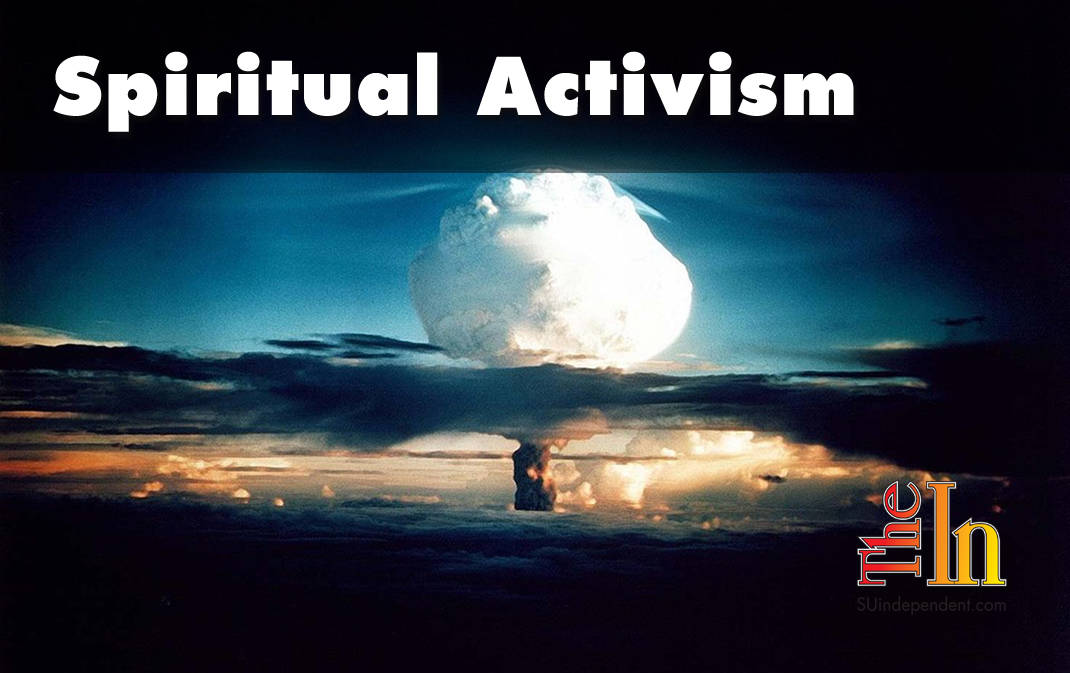 By Emily Rose
By Emily Rose
I am decidedly a millennial. The Berlin Wall came down three months before I was born, and I was in sixth grade math class when I saw the second plane hit the World Trade Center on live TV. My generation carries its own set of anxieties stemming from 9/11 to the Great Recession, but I have never hidden under my desk for a bomb drill in school. I have never mistaken thunder to be bombs in the middle of the night. The closest I can come to an experience like that is the story of my dad running home from school at six years old after he spotted a blimp on the playground and was convinced it was a nuclear bomb.
Last month, the Utah Campaign to Abolish Nuclear Weapons partnered with several local faith communities for a weekend honoring the downwinders of St. George. I hadn’t heard the story of the downwinders, but I learned that they were (and still are) impacted by the toxic fallout from nuclear tests in the Nevada desert. It was a weekend of beholding, honoring, and sacred memory.
We began with an interfaith worship service telling some of the personal stories of downwinders, singing songs of peace, and sharing how our particular faith traditions informed our stance against the destructive power of nuclear weapons. It was a beautiful gathering of our collective voices for peace.
On Saturday, we took a meditative walk through the St. George cemetery. We stopped at the gravesites of several people who died from diseases connected with radiation exposure, several of whom were children. There is something very holy about remembering the stories of those who have suffered. It was a time of holding space for the grief and loss in the community. We wanted to make sure that those impacted by the effects of nuclear testing were not forgotten.
I was blessed to hear stories from members of the Utah Campaign Against Nuclear Weapons. Many of the members were young during the Cold War, and they remembered the collective anxiety in the culture, in their homes, and in their schools. I believe that hearing these stories, especially as someone who was not born in the same generation to witness the events firsthand, is an act of sacred remembering. I felt connected to their experience, particularly because my generation has been shaped by anxiety about terrorism since 9/11. What I learned is that there is much work to do to create peace in this world, and much of it comes down to how much we let fear guide our actions. This is the power of memory. We open ourselves up to the lessons and stories of the past, such that it will compel us to shape a better future.
How can we shape a better future in St. George? The downwinders memorial event last weekend sparked some dreaming, and I think it is a good place to start. What would it look like to have a monument or historic site that tells the stories of the downwinders in our community? What if it were a monument of memory but also a call for peace? When we listen well to forgotten stories of history, we can dream a more peaceful future.
Beginning in 1993, my faith tradition, Community of Christ, has given an annual peace award to a person or organization that has worked for peace and justice in the world. In 2012, we honored Dr. Tadatoshi Akiba, a nuclear disarmament advocate and founder of Mayors for Peace, an organization that unites cities around the world in the work for nuclear disarmament.
From their mission statement, Mayors for Peace “strives to raise international public awareness regarding the need to abolish nuclear weapons and contributes to the realization of genuine and lasting world peace by working to eliminate starvation and poverty, assist refugees fleeing local conflict, support human rights, protect the environment, and solve the other problems that threaten peaceful coexistence within the human family.”
As of this month, there are 7,295 cities united around the world through Mayors for Peace. Right here in Utah, there are two, Springdale and Salt Lake City. What would it look like for St. George to stand alongside these 7,000 cities to call for courage and peace? What if we honored the downwinders by challenging city leaders to join with mayors around the world in standing up for nuclear disarmament? This is how sacred memory and storytelling become spiritual activism. How will we envision a more peaceful future for our community?



